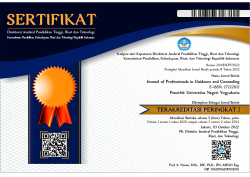Validity and reliability of the Indonesian version of cyber bullying perpetration (CBP) and victimization (CBV) instruments
Downloads
This study aimed to examine the validity and reliability of the Indonesian adaptation of the Cyber Bullying Perpetration (CBP) and Cyber Bullying Victimization (CBV) scales originally developed by Lee et al. (2017). The adaptation process involved translation, back-translation, expert judgment, and pilot testing to ensure conceptual and cultural equivalence. The final instrument consisted of 18 items rated on a four-point Likert scale (1 = never to 4 = very often) and was administered to a sample of 389 undergraduate students aged 19–22 years from three provinces in Sulawesi, Indonesia. The scales measured three dimensions of cyberbullying behavior: verbal-written bullying, visual-sexual bullying, and social exclusion. Results of the reliability analysis showed high internal consistency, with Cronbach’s alpha and McDonald’s omega coefficients exceeding 0.80 across most indicators. Confirmatory Factor Analysis (CFA) further demonstrated acceptable model fit indices, confirming that the adapted scales were theoretically robust and empirically supported. Although certain items in the social exclusion subscale showed lower correlations, the overall instrument demonstrated strong psychometric properties. These findings indicate that the Indonesian version of the CBP and CBV scales is both valid and reliable, making it suitable for research and practical applications in higher education contexts. The study contributes to the development of culturally relevant tools for assessing cyberbullying, providing essential insights for prevention, intervention, and future research.
Downloads
Ali, S. I., & Shahbuddin, N. B. (2022). The relationship between cyberbullying and mental health among university students. Sustainability, 14(11), 6881. https://doi.org/10.3390/su1411688
Alipan, A., Skues, J. L., Theiler, S., & Wise, L. (2020). Defining cyberbullying: A multifaceted definition based on the perspectives of emerging adults. International Journal of Bullying Prevention, 2, 79–92.
Aristawati, A. R., Meiyuntariningsih, T., Cahya, F. D., & Putri, A. (2021). Emotional Intelligence Dan Stres Pada Mahasiswa Yang Mengalami Quarter-Life Crisis. Psikologi Konseling.
Barus, R. K. I., & Dwiana, R. (2016). Cyberbullying Dan Sikap Pelajar Di Kota Medan Cyberbullying and Students Behaviour In Medan City. Jurnal Penelitian Pers Dan Komunikasi Pembangunan, 20(2), 99–108.
Batmaz, H., Türk, N., Kaya, A. et al. Cyberbullying and cyber victimization: examining mediating roles of empathy and resilience. Curr Psychol 42, 30959–30969 (2023). https://doi.org/10.1007/s12144-022-04134-3
Bernardo, A. B., Galve-González, C., Cervero, A., & Tuero, E. (2022). Cyberbullying in first-year university students and its influence on their intentions to drop out. Higher Education Research & Development, 42(2), 275–289. https://doi.org/10.1080/07294360.2022.2057447
Cassidy, W., Jackson, M., & Brown, K. N. (2009). Sticks and stones can break my bones, but how can pixels hurt me? Students’ experiences with cyber-bullying. School Psychology International, 30(4), 383–402.
Chen, M., Zhou, Y., Luo, D., Yan, S., Liu, M., Li, Y., & Liu, L. Z. (2023). Association of family function and suicide risk in teenagers with a history of self-harm behaviors: mediating role of subjective wellbeing and depression. Frontiers in Public Health, 11, 1164999.
Fauzi, M. A. (2024). Cyberbullying in higher education: a review of the literature based on bibliometric analysis. Kybernetes, 53(9), 2914–2933.
Fenn, J., Tan, C.-S., & George, S. (2020). Development, validation and translation of psychological tests. BJPsych Advances, 26(5), 306–315.
Fulantelli, G., Taibi, D., Scifo, L., Schwarze, V., & Eimler, S. C. (2022). Cyberbullying and cyberhate as two interlinked instances of cyber-aggression in adolescence: a systematic review. Frontiers in Psychology, 13, 909299.
Gao, M., Zhao, X., & McJunkin, M. (2016). Adolescents’ experiences of cyberbullying: Gender, age and reasons for not reporting to adults. International Journal of Cyber Behavior, Psychology and Learning (IJCBPL), 6(4), 13–27.
Gohal, G., Alqassim, A., Eltyeb, E., Rayyani, A., Hakami, B., Al Faqih, A., Hakami, A., Qadri, A., & Mahfouz, M. (2023). Prevalence and related risks of cyberbullying and its effects on adolescent. BMC Psychiatry, 23(1), 39.
Greco, G. (2020). Actions To Prevent And Counteract The Cyberbullying Phenomenon: An Overview. European Journal of Social Sciences Studies.
Guo, C., & Sim, T. (2025). Walsh Family Resilience Questionnaire Short Version (WFRQ-9): Development and Initial Validation for Disaster Scenarios. Disaster Medicine and Public Health Preparedness, 19, e39.
Hazime, M. (2024). The lived experience of middle school counselors with cyberbullying in the virtual learning environment. Walden University.
Herlambang, D., Zildjianda, R., & Brajannoto, D. (2025). Analysis of Cyberbullying Among Students: a Legal Perspective in Indonesia. Entita: Jurnal Pendidikan Ilmu Pengetahuan Sosial Dan Ilmu-Ilmu Sosial, 51–62.
Hu, Y., Bai, Y., Pan, Y., & Li, S. (2021). Cyberbullying victimization and depression among adolescents: A meta‑analysis. Psychiatry Research, 305, 114198. https://doi.org/10.1016/j.psychres.2021.114198
Hunt, C., Peters, L., & Rapee, R. M. (2012). Development of a measure of the experience of being bullied in youth. Psychological Assessment, 24(1), 156.
Kasanah, S. U., Rosyadi, Z., Pd, M., Punggeti, R. N., Arifin, F., Yasin, M., Khakim, A., Yudiati, R., Meita, N. M., & Krismayanti, Y. (2024). Pendidikan Anti Bullying. Basya Media Utama.
Kavaliauskienė, A., Šidlauskas, A., & Zaborskis, A. (2019). Modification and psychometric evaluation of the child perceptions questionnaire (CPQ 11–14) in assessing oral health related quality of life among Lithuanian children. BMC Oral Health, 19, 1–15.
Kim, M., Ellithorpe, M. E., & Burt, S. A. (2023). Anonymity and its role in digital aggression: A systematic review. Aggression and Violent Behavior, 72, 101856. https://doi.org/10.1016/j.avb.2023.101856
Lee, J., Abell, N., & Holmes, J. L. (2017). Validation of measures of cyberbullying perpetration and victimization in emerging adulthood. Research on Social Work Practice, 27(4), 456–467. https://doi.org/10.1177/1049731515578535
Lim, H., & Lee, H. (2021). Cyberbullying: Its social and psychological harms among schoolers. International Journal of Cybersecurity Intelligence & Cybercrime, 4(1), 25–45.
Livingstone, S., Stoilova, M., & Kelly, A. (2016). Cyberbullying: Incidence, trends and consequences. Ending the Torment: Tackling Bullying from the Schoolyard to Cyberspace, 115–120.
Macaulay, P. J. R., Betts, L. R., Stiller, J., & Kellezi, B. (2022). Bystander responses to cyberbullying: The role of perceived severity, publicity, anonymity, type of cyberbullying, and victim response. Computers in Human Behavior, 131, 107238. https://doi.org/10.1016/j.chb.2022.107238.
Mansyur, A. I., Badrujaman, A., Imawati, R., & Fadhillah, D. N. (2020). Konseling online sebagai upaya menangani masalah perundungan di kalangan anak muda. Jurnal Pendidikan Ilmu Sosial, 29(2), 140–154.
Maurya, C., Muhammad, T., Dhillon, P. et al. The effects of cyberbullying victimization on depression and suicidal ideation among adolescents and young adults: a three year cohort study from India. BMC Psychiatry 22, 599 (2022). https://doi.org/10.1186/s12888-022-04238-x
Myers, C.-A., & Cowie, H. (2019). Cyberbullying across the lifespan of education: Issues and interventions from school to university. International Journal of Environmental Research and Public Health, 16(7), 1217.
Ningrum, F. S., & Amna, Z. (2020). Cyberbullying victimization dan kesehatan mental pada remaja. INSAN Jurnal Psikologi Dan Kesehatan Mental, 5(1), 35–48.
Pabian, S., & Vandebosch, H. (2021). Perceived long-term outcomes of early traditional and Cyberbullying victimization among emerging adults. Journal of Youth Studies, 24(1), 91–109.
Paolini, A. (2018). Cyberbullying: Role of the School Counselor in Mitigating the Silent Killer Epidemic. International Journal of Educational Technology, 5(1), 1–8.
Peled, Y. (2019). Cyberbullying and its influence on academic, social, and emotional development of undergraduate students. Heliyon, 5(3).
Pinalis, D., Triyono, A., & Yulianto, L. (2024). Pemahaman Gen Z Terhadap Tindakan Cyberbullying Di Platform Instagram. Jurnal Common, 8(2), 178–192.
Prince Peprah, P., Oduro, M. S., Okwei, R., Adu, C., Asiamah‑Asare, B. Y., & Agyemang‑Duah, W. (2023). Cyberbullying victimization and suicidal ideation among in‑school adolescents in three countries: Implications for prevention and intervention. BMC Psychiatry, 23(1), Article 944. https://doi.org/10.1186/s12888-023-05268-9
Rihardi, S. A., Pembayun, J. G., & Yusliwidaka, A. (2022). Pembentukan Komunitas Anti Cyberbullying Di Kalangan Siswa Menegah Atas Sebagai Upaya Preventif Menuju Desa Sukosari Bebas Dari Perilaku. Indonesian Journal Of Community Service, 2(4), 397–404.
Riswanto, D., & Marsinun, R. (2020). Perilaku cyberbullying remaja di media sosial. Analitika: Jurnal Magister Psikologi UMA, 12(2), 98–111.
Rizkiyanto, E., Sudewo, F. A., & Rizkianto, K. (2024). Penegakan Hukum Terhadap Tindak Pidana Cyberbullying melalui Media Elektronik. Penerbit NEM.
Samadieh, H., Reshvanloo, F. T., & Lee, J. (2025). Cyberbullying Perpetration and Victimization Scales: Psychometric Properties of the Iranian Version in University Samples.
Shaikh, F. B., Rehman, M., Amin, A., Shamim, A., & Hashmani, M. A. (2021). Cyberbullying behaviour: a study of undergraduate university students. IEEE Access, 9, 92715–92734.
Slanbekova, G., Turgumbayeva, А., Umurkulova, M., Mukhamedkarimova, D., & Chung, М. (2024). The Phenomenon of Cyberbullying: a Comprehensive Literature Review. The Journal of Psychology and Sociology, 89(2), 25.
Smith, C. (2024). Cyberbullying Experiences During Adolescence and Prosocial Behaviors in Emerging Adulthood: Mechanisms of Moral Disengagement as Mediators. Oklahoma State University.
Smith, P. K. (2019). Research on cyberbullying: Strengths and limitations. Narratives in Research and Interventions on Cyberbullying among Young People, 9–27.
Sood, A., Sharma, D., Sharma, M., & Dey, R. (2024). Prevalence and repercussions of stress and mental health issues on primary and middle school students: A bibliometric analysis. Frontiers in Psychiatry, 15, 1369605.
Tinstman Jones, J. L., Campbell, L. O., Stickl Haugen, J., & Sutter, C. C. (2020). Cyberbullying considerations for school counselors: A social media content analysis. Professional School Counseling, 23(1), 2156759X20919365.
Triyono, T., & Rimadani, R. (2019). Dampak Cyberbullying Di Media Sosial Pada Remaja Dan Implikasinya Terhadap Pelayanan Bimbingan Dan Konseling. Jurnal Neo Konseling, 1(1).
Umar, N. F., Pandang, A., Syahril, M. F., & Rafli, M. (2024). Examining the Factor of Social Media Activities and Relationships of Cyberbullying Behaviour in Generation Z Indonesia. Bulletin of Counseling and Psychotherapy, 6(1).
Umar, N. F., Rafli, M., Dilah, N. J., & Mentari, N. N. (2022). Pengembangan U-Shield: Aplikasi Self-Defense Remaja Berbasis Strategi Komunikasi Asertif Pencegah Cyberbullying. Indonesian Journal of Learning Education and Counseling, 5(1), 35–43.
Wahanisa, R., Prihastuty, R., & Noho, M. D. H. (2021). Preventive measures of cyberbullying on adolescents in Indonesia: a legal analysis. Lentera Hukum, 8, 267.
Wang, L., & Ngai, S. S. (2020). The effects of anonymity, invisibility, asynchrony, and moral disengagement on cyberbullying perpetration among school-aged children in China. Children and Youth Services Review, 119, 105613. https://doi.org/10.1016/j.childyouth.2020.105613
Wright, M. F., & Wachs, S. (2023). Cyberbullying involvement and depression among elementary school, middle school, high school, and university students: the role of social support and gender. International Journal of Environmental Research and Public Health, 20(4), 2835.
Yosep, I., Hikmat, R., & Mardhiyah, A. (2023). Nursing intervention for preventing cyberbullying and reducing its negative impact on students: a scoping review. Journal of Multidisciplinary Healthcare, 261–273.
Zhou, Y., Li, D., Zhang, W., & Wang, Y. (2023). Moral disengagement and cyberbullying perpetration among adolescents: Empathy as a moderator. Children and Youth Services Review, 151, 107178. https://doi.org/10.1016/j.childyouth.2023.107178
Copyright (c) 2025 ProGCouns: Journal of Professionals in Guidance and Counseling

This work is licensed under a Creative Commons Attribution-ShareAlike 4.0 International License.
 | ProGCouns: Professional Guidance and Counseling Journal is licensed under a Creative Commons Attribution-ShareAlike 4.0 International License. |















